JAPAN’S OVERSEAS EXPANSION
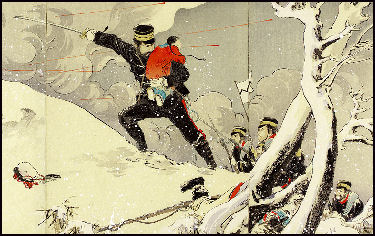 Japan was the dominant power of Asia in the late 19th and early 20th centuries. Meiji reforms and the rise in Japanese military strength helped allow Japan to abolish foreign treaty rights and bypass China to become the leader in Asia.
Japan was the dominant power of Asia in the late 19th and early 20th centuries. Meiji reforms and the rise in Japanese military strength helped allow Japan to abolish foreign treaty rights and bypass China to become the leader in Asia.
Disputes with China over sovereignty of the Ryukyu Islands, with Russia over sovereignty of the Kuril Islands and Sakhalin, and with Korea over the Korean court's refusal to recognize the new Meiji government and its envoys were all settled diplomatically between 1874 and 1876. Military threats had been made in the Chinese and Korean disputes, and it seemed to many that Japan would soon use military means to achieve its goals. [Source: Library of Congress]
Historically, Japan's main foreign preoccupation has been China. The Korean Peninsula, a strategically located feature critical to the defense of the Japanese archipelago, greatly occupied Japan's attention in the nineteenth century. Earlier tension over Korea had been settled temporarily through the Treaty of Kanghwa in 1876, which opened Korean ports to Japan, and through the Tianjin Convention in 1885, which provided for the removal from Korea of both Chinese and Japanese troops sent to support contending factions in the Korean court. In effect, the convention had made Korea a co-protectorate of Beijing and Tokyo at a time when Russian, British, and United States interests in the peninsula also were on the increase. [Ibid]
RELATED ARTICLES IN THIS WEBSITE: MEIJI PERIOD AND BEFORE WORLD WAR II factsanddetails.com; PERRY, BLACK SHIPS AND JAPAN OPENS UP factsanddetails.com; MEIJI PERIOD (1868-1912) EMPEROR, LEADERS AND STATE SHINTO factsanddetails.com; MEIJI PERIOD (1868-1912) REFORMS, MODERNIZATION AND CULTURE factsanddetails.com; JAPAN IN THE EARLY 20TH CENTURY: TAISHO PERIOD (1912-1926) THE TOKYO EARTHQUAKE factsanddetails.com; JAPAN BEFORE WORLD WAR II: THE RISE OF JAPANESE MILITARISM AND NATIONALISM factsanddetails.com; EMPEROR HIROHITO factsanddetails.com
Good Websites and Sources: Sino-Japanese War Sino-Japanese War.com sinojapanesewar.com ; Wikipedia article on the Sino-Japanese War Wikipedia ; Sino-Japanese War Images MIT Visualizing Culture Making of Modern Japan, Google e-book books.google.com/books ; Russo-Japanese War Treaty of Portsmouth Text net.lib.byu.edu ; Library of Congress Article frontiers.loc.gov ; Wikipedia article Wikipedia ; Japan Conflicts Between 1800 and 1999 on Wars of the World onwar.com/aced/nation/jay/japan Russo-Japanese War Images MIT Visualizing Culture and MIT Visualizing Culture ;After the Russo-Japanese War Images MIT Visualizing Culture ; Essay on Humor, China and Japan aboutjapan.japansociety.org
RECOMMENDED BOOKS: “Rising Sun and Tumbling Bear: Russia's War with Japan” by Richard Connaughton Amazon.com; “Much Recorded War: The Russo-Japanese War In History And Imagery” by Sebastian Dobson, Anne Nishimura Morse, et al. Amazon.com; “The Russo-Japanese War 1904-1905 by Geoffrey Jukes Amazon.com; “The Russo-Japanese War 1904–05 (Men-at-Arms) Amazon.com; “Human Bullets: A Soldier's Story of the Russo-Japanese War” by Tadayoshi Sakurai and Roger J. Spiller Amazon.com; “The Russo-Japanese War at Sea 1904-5: Volume 1-Port Arthur, the Battles of the Yellow Sea and Sea of Japan” by Vladimir Semenoff Amazon.com; “Japan at War in the Pacific: The Rise and Fall of the Japanese Empire in Asia: 1868-1945" by Jonathan Clements Amazon.com

Sino-Japanese War
Sino-Japanese War
In the Sino-Japanese War (1894-95), Japan easily defeated China in a war that would decide who would control the Korean peninsula. Known as the Jiawu War in China, the Sino-Japanese War lasted only year. The decisive moment was the surprising defeat of the Chinese navy at the Battle of the Yalu River in 1894.Weakened by decades of foreign occupation, China was forced to sign a series of unequal treaties with Japan. The Treaty of Shimonoseki forced China to cede Taiwan and the Penghu Islands, pay a large indemnity, allow Japanese industry into four treaty ports and recognize Japan's hegemony over Korea (even though the Korean peninsula was officially granted the independence). China also ceded Port Arthur and the Liaotung peninsula in southern Manchuria to Japan.
A crisis was precipitated in 1894 when a leading pro-Japanese Korean political figure was assassinated in Shanghai with Chinese complicity. Prowar elements in Japan called for a punitive expedition, which the cabinet resisted. With assistance from several Japanese nationalistic societies, the illegal Tonghak (Eastern Learning) nationalistic religious movement in Korea staged a rebellion that was crushed by Chinese troops. Japan responded with force and quickly defeated China in the First Sino-Japanese War (1894-95). After nine months of fighting, a cease-fire was called and peace talks were held. The victor's demands were such that a Japanese protectorate over China seemed in the offing, but an assassination attempt on Li Hongzhang, China's envoy to the peace talks, embarrassed Japan, which then quickly agreed to an armistice. The Treaty of Shimonoseki accomplished several things: recognition of Korean independence; cessation of Korean tribute to China; a 200 million tael (Chinese ounces of silver, the equivalent in 1895 of US$150 million) indemnity to Korea from China; cession of Taiwan, the Penghu Islands, and the Liaodong Peninsula (the southern part of Manchuria) to Japan; and opening of Chang Jiang (Yangtze River) ports to Japanese trade. It also assured Japanese rights to engage in industrial enterprises in China. [Source: Library of Congress]
Having their own imperialist designs on China and fearing China's impending disintegration, Russia, Germany, and France jointly objected to Japanese control of Liaodong. Threatened with a tripartite naval maneuver in Korean waters, Japan decided to give back Liaodong in return for a larger indemnity from China. Russia moved to fill the void by securing from China a twenty-five-year lease of Dalian (Dairen in Japanese, also known as Port Arthur) and rights to the South Manchurian Railway Company, a semioffical Japanese company, to construct a railroad. Russia also wanted to lease more Manchurian territory, and, although Japan was loath to confront Russia over this issue, it did move to use Korea as a bargaining point: Japan would recognize Russian leaseholds in southern Manchuria if Russia would leave Korean affairs to Japan. The Russians only agreed not to impede the work of Japanese advisers in Korea, but Japan was able to use diplomatic initiatives to keep Russia from leasing Korean territory in 1899. At the same time, Japan was able to wrest a concession from China that the coastal areas of Fujian Province, across the strait from Taiwan, were within Japan's sphere of influence and could not be leased to other powers. In 1900 Japanese forces participated in suppressing the Boxer Uprising, exacting still more indemnity from China.
See Separate Article: SINO-JAPANESE WAR (1894-1895) factsanddetails.com

Japanese battleships
Russo-Japanese War
In 1904-1905, Japan defeated Russia in Russo-Japanese War, showing that the world that Japan was major world power and that Czarist Russia was on its last legs. The Japanese attacked the Russians in Korea and Manchuria. Despite tremendous loss of life on both sides, the Japanese won a series of land battles and then decisively and unexpectedly crushed Russia's Baltic Sea Fleet at the Battle of Tsushima in May 1905. The Japanese lost 60,000 men and the Russians, 30,000. One general described the war as a “mountain of corpses.”
At the beginning of the war Russia was considered one of the world's super powers and the Japanese army was still regarded as second rate. Most people thought that Russia would easily win. Some saw the conflict as the first modern war. It at least was the first modern naval war in which ironclad navies with long-range guns faced one another. But it was also a war of old-style military maneuvers such as a Cossack charges, the scaling of ancient city walls and elaborate courtesies between commanders.
The Russo-Japanese War was the first major war of the 20th century. The use of barbed wire, trenches and land mines gave a hint of things to come in World War I. There were also major anti-war protests. The Bloody Sunday incident in which Russian demonstrators were killed in January 1905 made it difficult for Russia to continue the war against Japan. In Tokyo, people rioted to protest the signing of the Treaty of Portsmouth and size of the compensation paid to Russia. Even before the Russo-Japanese War, an astute Polish banker named Jan Block predicted future wars would be long wars of attrition that would kill many people and destroy economies. He warned Russia in particular to be careful because such a war could lead to an overthrow of the government by revolution.
The Russo-Japanese was perhaps the first war in which radio communications played a major role in the outcome of the conflict, The Japanese received radio reports of the state of the Russian Baltic fleet before it arrived in Japanese waters. It also marked the beginning of the involvement of the United States in international affair as it took a major role in the peace settlement.
During the Russo-Japanese War, The Times became the first newspaper to use wireless telegraphy to cover a war. When a Russian torpedo flotilla was sunk trying to attack Port Arthur, Colonel James who had the use of a specially fitted-out boat and 55 meter mast erected on shore, reported it to London before Japan even knew the attack had been made. Chartering the boat and all the equipment was quite expensive. [Source: The Times]
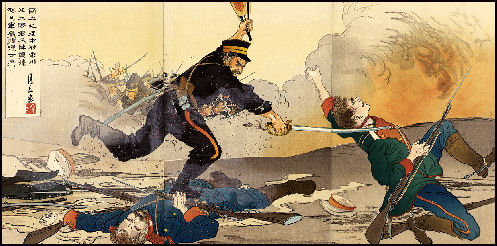
Japanase propaganda poster from Russo-Japanese War
Events Before Russo-Japanese War
The origin of the war dated back to the end of the war against China in 1885 when Russia, Germany and France asked Japan to leave Port Arthur (Dalian) and the Liaotung Peninsula in northeast China. Japan gave into the demands. In 1886, Russia seized the territory for itself and then occupied Manchuria.
In 1875, Russia and Japan agreed on how to divide the islands east of Russia. Russia got Sakhalin Island and the Japanese got the Kuril Islands. Disagreement arose on "spheres of influence" in which Russia wanted Manchuria and Japan wanted Korea.
Japan prepared for war by strengthening its navy and forming an alliance with Britain, the world' leading trade and naval power. Japan and Britain, both of whom wanted to keep Russia out of Manchuria, signed the Treaty of Alliance in 1902.The British recognized Japanese interests in Korea and assured Japan they would remain neutral in case of a Russo-Japanese war but would become more actively involved if another power (probably an allusion to France) entered the war as a Russian ally. In the face of this joint threat, Russia became more conciliatory toward Japan and agreed to withdraw its troops from Manchuria in 1903. The new balance of power in Korea favored Japan and allowed Britain to concentrate its interests elsewhere in Asia. Hence, Tokyo moved to gain influence over Korean banks, opened its own financial institutions in Korea, and began constructing railroads and obstructing Russian and French undertakings on the peninsula.
Poor diplomacy was based on starting the war. When Russia failed to withdraw its troops from Manchuria by an appointed date, Japan issued a protest. Russia replied that it would agree to a partition of Korea at the thirty-ninth parallel, with a Japanese sphere to the south and a neutral zone to the north. But Manchuria was to be outside Japan's sphere, and Russia would not guarantee the evacuation of its troops. Despite the urging of caution by most genro, Japan's hardliners issued an ultimatum to Russia, which showed no signs of further compromise. In 1904, Japan broke diplomatic relations with Russia.
Early Fighting in the Russo-Japanese War
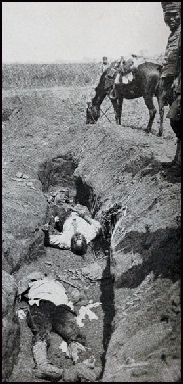
War broke out in February 1904 with Japanese surprise attacks on Russian warships at Dalian and Chemulpo (in Korea, now called Inch'on). After the Russians refused to leave Manchuria and a timber concession in Korea, the Japanese launched a Pearl Harbor-like, pre-emptive surprise attack against the Russian Pacific Fleet in Port Arthur, Russia's only ice-free port on the Pacific, and then conducted a successful blockade of the Russian fleet in Port Arthur. Between August 1904 to January 1905, the Japanese proceed to lay waste to Russia’s Pacific fleet and captured Port Arthur on January 2, 1905. During the siege, 56,000 Japanese died.
With its fleet destroyed trapped in Port Arthur, the Russians tried to win the war on land but were stopped by a highly motivated Japanese troops, who poured onto the Liaotung Peninsula in large numbers. The pivotal Battle of Sha Ho ended in a stalemate and both sides dug into trenches World-War-I-style behind barbed wire lines and remained in their positions for months.
Russia had difficulty supplying it forces. The source of men and supplies were thousands of miles away. With Port Arthur cut off, the only way to bring supplies was on the single-track Trans Siberian Railroad, which had not yet been completed. In 1904, rails were laid down on the three foot ice of Lake Baikal to bring goods east. The first train plunged through the ice and left behind a 15-miles long hole. The Russian didn't give up. A new track was laid and men and horses were used successfully to pull the rail cars across the ice rather than heavy locomotives.
There was a great deal of fighting on land, One press release describing the attack on “Hill of 203 meters” from 1904 went: The Japanese “made many charges before four o’clock in the afternoon, but were driven back by the desperate Russians. At five o’ clock the Japanese troops advanced against the south-eastern portion of the hill, charged valiantly and reached within thirty yards of the summit. At seven o’clock, reinforced, they charged again and captured the hill. At eight o’clock the entire summit was in the possession of the besieging army. The Russians left vast heaps of dead on the fields.”
The Russian troops were led by Gen. Alexei Nikolayevich Kuropatkin (1848-1925). Most engagement resulted in Japanese victories that drove the Russians back. The most crushing Russian defeats occurred at Liaoyang in 1904 and Mukden in 1905. Making matters worse for Russia were revolts at home.
Japanese Soldiers in the Russo-Japanese War
The Russo-Japanese War also saw the rise of samurai virtues on the international scene. Japanese soldiers were taught that to die in battle was noble and anything less was a humiliation. Many of these soldiers, who referred to themselves as the Emperor's human bullets, formed human waves that were mowed down by Russian machine guns during attacks on fortifications that surrounded Port Arthur, the main Japanese objective.
The Japanese generally fought the war in a humane way. Captured Russian soldiers were treated well and let go after they had been neutralized militarily. POWs were taken to a camp in Masuyama in first-class train coaches, allowed to learn to read and write Japanese and could walk freely around the city. But there were ugly signs of things to come: at Mukden Japanese came upon thousands of drunk Russian soldiers and instead of capturing them they were bludgeoned and disemboweled with bayonets. There was also the execution of 130 captures Russian soldiers on Sakhalin island.

Russo-Japanese War trench warfare
The Japanese forces were led by General Maresukae Nogi and Admiral Togo. Nogi perhaps is best known for marking the death of Emperor Meiji by committing suicide with his wife in 1912. Gen. Nogi committed ritual suicide (seppaku). His wife, apparently willingly, plunged a dagger into her heart. In 1877 Nogi had asked the Emperor for permission to commit seppaku following his regiment’s defeat in the Satsuma Rebellion and the loss of the Emperor’s banner to the enemy. He was crushed when his request was turned down, expressing his feelings a poem that went: “My self is nothing but a person scared of death.” He made the request for seppaku again in 1905 after losing two sons in the war and again was turned down. The state propaganda machine seized up his successful suicide as the ultimate act of self-sacrifice for the emperor and was used for propaganda purposes to aid the rise of the military. A number of writers wrote about the event.
Russia's Baltic Fleet Sails to the Pacific
The war was popular and widely supported in Japan but unpopular and seen as remote in Russia. The Russian forces were largely illiterate and often drunk. They lacked motivation and a desire to fight.
Many of the Russians actions and inactions proved to disastrous on a grand scale. On October 9, 1904, Czar Nicholas II ordered his "invincible" 42-ship Baltic fleet to sail 18,000 miles around the world to waters off of China. In the North Sea, the Russians sunk one Japanese "torpedo boat" and damaged several others. These boats ended up being British trawlers.
The Russian fleet sailed around Africa to the Indian Ocean and picked up 10 more ships, mostly antiques, in Vietnam. As the fleet entered waters off China, Russian admiral Zinovi Rozhdestvenski decided to head straight to Vladivostok, the only Russian port left in Asia, through the narrow Tsushima Strait, which separates Japan and Korea.
Battle of Tsushima
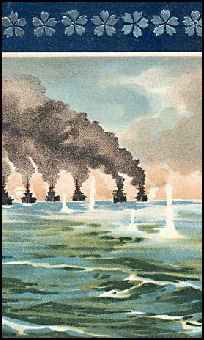
Admiral Heihachiro Togo guessed of the Russian plan and waited with the entire Japanese fleet in the Tsushima Strait. The Russians sailed into the trap on May 27, 1905.
Togo was able to maneuver the faster, better-built Japanese ships on the sides of the advancing Russian ships and blast away at them. The Russian flag ship was one of eh first to go down. It was followed by three more battleships. The pride of the Russian navy, the “Borodino”, sank in seconds after a single Japanese shell land in its ammunition magazine.
The 12 surviving Russian ships were pursued and encircled by Japanese torpedo ships. The Russian ships surrendered. Of the 52 ships in the Russian fleet only three made it to Vladivostok. More than 10,000 Russians were injured or captured and 4,830 were killed. By contrast the Japanese only lost three small torpedo ships, and 1,000 Japanese sailors were wounded and 117 were killed.
Togo was heralded as the great hero of the Russo-Japanese war. He was honored not only in Japan but around the globe. In the Netherlands and Finland there are beers named after him. In Istanbul you can find Togo Avenue. One of his greatest admirers was Adm. Chester Nimitz, commander of the U.S. Pacific fleet in World War II. Nimitz attended Togo's funeral, donated royalties from a book to a Togo shrine.
Treaty of Portsmouth and the End of the Russo-Japanese War
Russia surrendered and signed a peace treaty on September 5, 1905 in Portsmouth, New Hampshire in the United States. The Japanese asked U.S. president Teddy Roosevelt to mediate the settlement. Roosevelt won the Nobel Peace Prize for his efforts to get the two nations to sign the treaty. This was the first Nobel prize to go to an American.
According to Columbia University’s Asia for Educators: “The short but bloody Russo-Japanese War of 1904-1905 was extremely costly (both financially and in terms of human lives) for the two combatant nations. Although the Japanese could claim a string of battlefield triumphs, culminating in the stunning victory over the Russian fleet in the Tsushima Strait in May 1905, both nations were eager to negotiate a peace. With the mediation of U.S. President Theodore Roosevelt, representatives of the Japanese Emperor and the Russian Tsar met in Portsmouth, New Hampshire, in August 1905. Although the Japanese expected substantial territorial concessions (and a large monetary indemnity) from the Russians, they were out-maneuvered in the negotiations and were forced to settle for more modest spoils of victory. The Treaty of Portsmouth was signed on September 5, 1905. For his role in brokering an end to the Russo-Japanese War, President Roosevelt was awarded the Nobel Peace Prize in 1906. [Source: Asia for Educators Columbia University, Primary Sources with DBQs, afe.easia.columbia.edu ]
At the American-mediated peace conference in Portsmouth, Russia acknowledged Japan's paramount interests in Korea and agreed to avoid "military measures" in Manchuria and Korea. Both sides agreed to evacuate Manchuria, except for the Guandong Territory (a leasehold on the Liaodong Peninsula) and restore the occupied areas to China. Russia transferred its lease on Dalian and adjacent territories and railroads to Japan and granted Japan fishing rights in the Sea of Okhotsk and the Bering Sea.
The peace agreement was largely seen as a compromise and in the eyes of the Japanese a capitalization. Even though Japan’s victory at sea was decisive its army could not prevail over the Russian army on land. Even after the war was over the armies of the two nations faced down each other in Manchuria and it often seemed there was a risk that a new conflict would erupt any time.
Russian war bonds sold well. Japanese ones did not. Among those who bought large amounts of Japanese ones was Lehman Brothers brokerage.
Treaty of Portsmouth (1905)
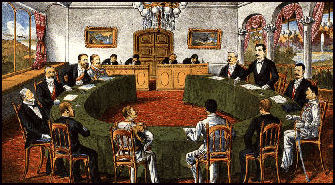
Treaty of Portsmouth meeting Excerpts from The Treaty of Portsmouth (1905): ARTICLE I. There shall henceforth be peace and amity between their Majesties the Emperor of Japan and the Emperor of all the Russias, and between their respective States and subjects. [Source: “Portsmouth Peace Treaty,” 1905-2005, 2009, Japan-America Society of New Hampshire. This text was reproduced from Sydney Tyler, “The Japan-Russia War,” (Harrisburg: The Minter Company, 1905), 564-568; Asia for Educators Columbia University, Primary Sources with DBQs, afe.easia.columbia.edu ]
ARTICLE II. The Imperial Russian Government, acknowledging that Japan possesses in Korea paramount political, military and economical interests, engages neither to obstruct nor interfere with measures for guidance, protection and control which the Imperial Government of Japan may find necessary to take in Korea. …
ARTICLE III. Japan and Russia mutually engage: “First.” — To evacuate completely and simultaneously Manchuria, except the territory affected by the lease of the Liaotung Peninsula, in conformity with the provisions of the additional
ARTICLE I annexed to this treaty, and, “Second.” — To restore entirely and completely to the exclusive administration of China all portions of Manchuria now in occupation, or under the control of the Japanese or Russian troops, with the exception of the territory above mentioned. The Imperial Government of Russia declares that it has not in Manchuria any territorial advantages or preferential or exclusive concessions in the impairment of Chinese sovereignty, or inconsistent with the principle of equal opportunity.
ARTICLE IV. Japan and Russia reciprocally engage not to obstruct any general measures common to all countries which China may take for the development of the commerce or industry of Manchuria.
ARTICLE V. The Imperial Russian Government transfers and assigns to the Imperial Government of Japan, with the consent of the Government of China, the lease of Port Arthur, Talien and the adjacent territory and territorial waters, and all rights, privileges and concessions connected with or forming part of such lease, and it also transfers and assigns to the Imperial Government of Japan all public works and properties in the territory affected by the above.mentioned lease. …
ARTICLE VI. The Imperial Russian Government engages to transfer and assign to the Imperial Government of Japan, without compensation and with the consent of the Chinese Government, the railway between Changchunfu and Kuanchangtsu and Port Arthur, and all the branches, together with all the rights, privileges and properties appertaining thereto in that region, as well as all the coal mines in said region belonging to or worked for the benefit of the railway. The two high contracting parties mutually engage to obtain the consent of the Government of China mentioned in the foregoing stipulation…
ARTICLE IX. The Imperial Russian Government cedes to the Imperial Government of Japan in perpetuity and full sovereignty the southern portion of the Island of Saghalin and all the islands adjacent thereto and the public works and properties thereon. The fiftieth degree of north latitude is adopted as the northern boundary of the ceded territory. The exact alignment of such territory shall be determined in accordance with the provisions of the additional
ARTICLE XI. Russia engages to arrange with Japan for granting to Japanese subjects rights of fishery along the coasts of the Russian possession in the Japan, Okhotsk and Bering Seas.
Results and Impact of the Wars with China and Russia

Treaty of Portsmouth
As a result of the war Russia was forced to cede Port Arthur and the Liaotung Peninsula and southern half of Sakhalin Island to Japan, to evacuate Manchuria, to recognize Korea as a Japanese protectorate and grant Japanese fishing rights north of Vladivostok. Russia obtained a lease for the southern tip of the Liaotung peninsula, where Port Arthur (present-day Lushan and Dalien) are located. The Japanese kept troops on the Liaotung Peninsula and used it as a foothold into Manchuria. Germany, France and Russia objected to Japan's claims in China.
History has shown that making one concession after another simply to keep an adversary at bay may be worthwhile as a temporary measure, but maintaining such an approach often can lead to a major defeat that impairs national interests.
To many outsiders the outcome was seen more as a Russian defeat than a Japanese victory. It was seen as sign of Russian weakness, which paved the way for the Russian Revolution and events in World War I. The shortness and the decisiveness of the war gave Japanese confidence and did not deplete its resources to a degree that would have made the Japanese think twice about entering conflicts in the future.
The Russo-Japanese War was the first major war of the 20th century. The use of barbed wire, trenches and land mines gave a hint of things to come in World War I. There were also major anti-war protests. The Bloody Sunday incident in which Russian demonstrators were killed in January 1905 made it difficult for Russia to continue the war against Japan. In Tokyo, people rioted to protest the signing of the Treaty of Portsmouth and size of the compensation paid to Russia. Even before the Russo-Japanese War, an astute Polish banker named Jan Block predicted future wars would be long wars of attrition that would kill many people and destroy economies. He warned Russia in particular to be careful because such a war could lead to an overthrow of the government by revolution.
The Russo-Japanese was perhaps the first war in which radio communications played a major role in the outcome of the conflict, The Japanese received radio reports of the state of the Russian Baltic fleet before it arrived in Japanese waters. It also marked the beginning of the involvement of the United States in international affair as it took a major role in the peace settlement.
Legacy of the Wars with China and Russia
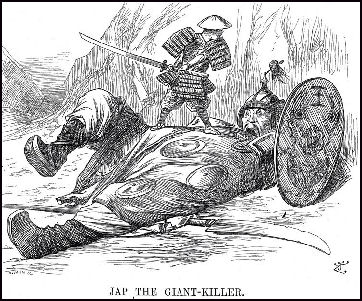
from Britain's Punch magazine The Russo-Japanese war halted European expansion into East Asia and provided an international structure for East Asia that brought some degree of stability to the region. It also changed the world from a European-centered world to one in which a new pole was emerging in Asia. After the defeat of Russia, a Persian newspaper wrote: “Although the European politicians and philosophers have said that Asia is not qualified to reach the levels of Western civilization, this was proven to be false.”
Japanese nationalism intensified after the Russo-Japanese War, and a new phase of continental expansion began after 1905. Politically and economically, Korea became a protectorate of Japan and in 1910 was formally annexed as a part of the empire. By means of the South Manchurian Railway, Japanese entrepreneurs vigorously exploited Manchuria. By 1907 Russia had entered into a treaty arrangement with Japan whereby both sides recognized the other's sphere of influence in Manchuria.
The Russo-Japanese War brought Japan to the attention of the world as a power to be reckoned with and the uncontested leader of Asia. The defeat of Russia was seen as a slap in the face for all of Europe. It was the first defeat of a major European power since the Mongols. But not everyone saw it such grim terms. Many, especially the British, cheered Japan’s success. Some conservatives in Britain applauded “brave little Japan.”
The victories over Russia and China, established Japan as the first great, modern, non-Western power in Asia. The Japanese leaders felt it was their duty to avenge the humiliation inflicted on Asia during the colonial period after the Opium War in 1842.
By defeating Russia, Japan knocked out its only naval rival in the eastern Pacific. Japan also took over Russia's concessions in China and annexed half of Sakhalin island, which later was used as a stepping stone to Manchuria and Korea. The failure to seize significant territory in Russia and China was considered a setback not because it was threat to Japan's military an economic interests but because considered a sign of weakness that ran contrary to the "stud duck in the pond" image that Japan was trying to project.
Image Sources: Visualizing Culture, MIT Education
Text Sources: Asia for Educators Columbia University, Primary Sources with DBQs, afe.easia.columbia.edu ; Ministry of Foreign Affairs, Japan; Library of Congress; Japan National Tourist Organization (JNTO); New York Times; Washington Post; Los Angeles Times; Daily Yomiuri; Japan News; Times of London; National Geographic; The New Yorker; Time; Newsweek, Reuters; Associated Press; Lonely Planet Guides; Compton’s Encyclopedia and various books and other publications. Many sources are cited at the end of the facts for which they are used.
Last updated September 2016
